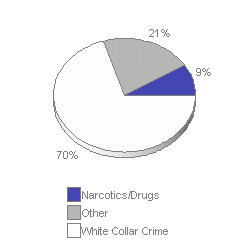Internal Revenue Service Convictions for 2007The latest available data from the Justice Department show that during FY 2007 the government reported 1,081 new convictions which had been referred by the Internal Revenue Service. According to the case-by-case information analyzed by the Transactional Records Access Clearinghouse (TRAC), this number is down 1% over the past fiscal year when the number of convictions totaled 1,092.
The comparisons of the number of defendants convicted for offenses are based on case-by-case information obtained by TRAC under the Freedom of Information Act from the Executive Office for United States Attorneys. (See Table 1) When this number of FY 2007 convictions of this type is compared with those five years ago where there were 1,017, the number of convictions was up (6.3 percent). But the number of convictions for the past year were much lower than they were ten years ago. Overall, the data show that convictions of this type are down 35.9 percent from level of 1,686 reported in 1997 and down 36.6 percent from the level of 1,704 reported in 1987. The long term trend in convictions for these matters going back to FY 1987 is shown more clearly in Figure 1. The vertical bars represent the number of convictions of this type recorded each fiscal year. Each presidential administration is distinguished by the color of the bars. Leading Program AreasCases were classified by prosecutors into more specific types. The single largest number of convictions of these matters through September 2007 was for "White Collar Crime", accounting for 70.1 percent of convictions. The second largest number of matters were Convictions filed under the program area of "Narcotics/Drugs " (8.9%) . The "Other" category in Figure 2 is comprised of a diverse group of programs. The largest specific programs within the "Other" category were: Government Regulatory" (7.1%). [The Department of Justice is withholding the program area for 5.2 percemt of the cases. These matters are also included in the "Other" category. TRAC, in ongoing litigation, has challenged the government's withholding of program category, winning a substantial victory in a September 2006 decision. The government, however, has filed a notice of appeal which has stayed the order requiring it to release program information.] Top Ranked Lead ChargesTable 2 shows the top lead charges recorded for cases which resulted in convictions in U.S. District Court during FY 2007. Note: There were an additional 72 other lead charges which were not individually ranked.
Table 2: Top charges for convictions
Among these top ten lead charges, the one showing the greatest increase in convictions—up 150 percent—compared to one year ago was Title 21 U.S.C Section 841 that involves "Drug Abuse Prevention + Control-Prohibited Acts A." This was the same statute that had the largest increase—114%—when compared with five years ago. Again among the top ten lead charges, the one showing the sharpest decline in convictions compared to one year ago—down 30.6 percent—was "Mail Fraud - Frauds and Swindles" (Title 18 U.S.C Section 1341). This was the same statute that had the largest decrease—52.5%—when compared with five years ago. Top Ranked Judicial DistrictsDuring FY 2006 the Justice Department said the government obtained 3.7 convictions for every one million people in the United States. The level during FY 2007 was essentially unchanged at again 3.7 convictions. Understandably, there is great variation in the per capita number of convictions in each of the nation's ninety-four federal judicial districts
Table 3: Top 10 districts (per one million people)
Except for districts with large populations, a relatively small difference in the number of convictions can have a substantial effect on these rankings. Hence we see considerable year-to-year change in relative district rankings. Nonetheless, Nevada, Hawaii, the Southern District of Alabama (Mobile), and the Northern District of Oklahoma (Tulsa) have placed in the top rankings more often than not across the years shown. Despite being the locus of major cities, the District of Columbia, and the Northern District of Illinois (Chicago) do not show up in the top ten in Table 3 in previous years. And the federal judicial district which showed the greatest growth in the rate of convictions compared to one year ago—399 percent—was Washington, D.C. (Washington). Compared to five years ago, the district with the largest growth—191 percent—was Northern District of Illinois (Chicago) . In the last year, the judicial District Court recording the largest drop in the rate of convictions—37.5 percent—was Southern District of Alabama (Mobile). |
|||||||||||||||||||||||||||||||||||||||||||||||||||||||||||||||||||||||||||||||||||||||||||||||||||||||||||||||||||||||||||||||||||||||||||||||||||||||||||||||||||||||||||||||||||||||||||||||||||||||||||||||


